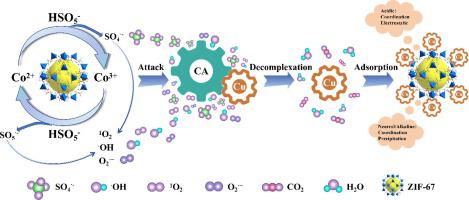当前位置:
X-MOL 学术
›
Chem. Eng. J.
›
论文详情
Our official English website, www.x-mol.net, welcomes your feedback! (Note: you will need to create a separate account there.)
One-step rapid removal of Cu(II) complexes via dual-active-site MOF catalysis with Peroxymonosulfate: Cooperative oxidation and adsorption
Chemical Engineering Journal ( IF 13.3 ) Pub Date : 2024-06-29 , DOI: 10.1016/j.cej.2024.153604 Shuo Wang , Simeng Guo , Xuedong Du , Ziqian Liu , Yujia Yang , Yaran Song , Qingrui Zhang
Chemical Engineering Journal ( IF 13.3 ) Pub Date : 2024-06-29 , DOI: 10.1016/j.cej.2024.153604 Shuo Wang , Simeng Guo , Xuedong Du , Ziqian Liu , Yujia Yang , Yaran Song , Qingrui Zhang

|
The removal of heavy metal complexes (HMCs) from wastewater is challenging due to their structural stability. Traditional methods require advanced oxidation processes (AOPs) for decomplexation, followed by chemical precipitation or adsorption. This study proposes a one-step approach using Co-imidazolate zeolitic framework-67 (ZIF-67) for simultaneous oxidation-decomplexation and adsorption of HMCs. The ZIF-67/peroxymonosulfate (PMS) system achieves 97.8 % removal of Cu(II)-citric acid complex (Cu-CA) in 60 mins, even under alkaline conditions, and demonstrates strong selectivity against ions like Ca, Mg, Na, and humic acid (HA). It effectively treats various contaminated water sources, achieving over 90 % removal efficiency for Cu(II) complexes such as oxalic acid (OA) and ethylenediaminetetraacetic acid (EDTA). The mechanism involves sulfate radicals (SO) and singlet oxygen (O) for decomplexation, followed by amine groups in MOFs capturing Cu(II) ions through coordination interactions. This work offers a straightforward one-step method for HMCs contamination mitigation.
中文翻译:

通过双活性位点 MOF 催化与过一硫酸盐一步快速去除 Cu(II) 配合物:协同氧化和吸附
由于重金属络合物 (HMC) 的结构稳定性,从废水中去除重金属络合物 (HMC) 具有挑战性。传统方法需要高级氧化工艺 (AOP) 进行解络,然后进行化学沉淀或吸附。本研究提出了一种使用 Co-咪唑盐沸石骨架 67 (ZIF-67) 同步氧化-解络和吸附 HMC 的一步法。即使在碱性条件下,ZIF-67/过一硫酸盐 (PMS) 系统也能在 60 分钟内实现 97.8% 的 Cu(II)-柠檬酸复合物 (Cu-CA) 去除率,并且对 Ca、Mg、Na、和腐植酸(HA)。它可以有效处理各种受污染的水源,对草酸 (OA) 和乙二胺四乙酸 (EDTA) 等 Cu(II) 络合物的去除效率超过 90%。该机制涉及硫酸根 (SO) 和单线态氧 (O) 解络,然后 MOF 中的胺基通过配位相互作用捕获 Cu(II) 离子。这项工作为减轻 HMC 污染提供了一种简单的一步法。
更新日期:2024-06-29
中文翻译:

通过双活性位点 MOF 催化与过一硫酸盐一步快速去除 Cu(II) 配合物:协同氧化和吸附
由于重金属络合物 (HMC) 的结构稳定性,从废水中去除重金属络合物 (HMC) 具有挑战性。传统方法需要高级氧化工艺 (AOP) 进行解络,然后进行化学沉淀或吸附。本研究提出了一种使用 Co-咪唑盐沸石骨架 67 (ZIF-67) 同步氧化-解络和吸附 HMC 的一步法。即使在碱性条件下,ZIF-67/过一硫酸盐 (PMS) 系统也能在 60 分钟内实现 97.8% 的 Cu(II)-柠檬酸复合物 (Cu-CA) 去除率,并且对 Ca、Mg、Na、和腐植酸(HA)。它可以有效处理各种受污染的水源,对草酸 (OA) 和乙二胺四乙酸 (EDTA) 等 Cu(II) 络合物的去除效率超过 90%。该机制涉及硫酸根 (SO) 和单线态氧 (O) 解络,然后 MOF 中的胺基通过配位相互作用捕获 Cu(II) 离子。这项工作为减轻 HMC 污染提供了一种简单的一步法。






































 京公网安备 11010802027423号
京公网安备 11010802027423号